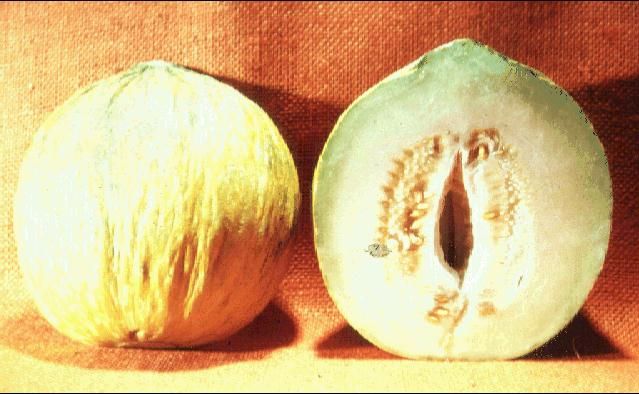Melon, Casaba—Cucumis melo L. (Inodorus group)1
The casaba melon belongs to the winter melon group, which also includes the honeydew type. They are closely related to netted melons that we commonly call cantaloupes (Cucumis melo var. reticulatus). All the melons within the melo species are known as muskmelons.
The casaba is a native of Asia Minor. Most commercial production of casabas is located in the southwestern United States, particularly California. In Florida it is grown occasionally in home gardens. The main drawback to production in this state is casaba's late maturity (120 days), which means it must ripen in our hot, wet months of early summer. Also, it is susceptible to leaf diseases.
Description
The casaba melon grows on a vine similar to that of a cantaloupe. While about the same size, fruits are not netted like the cantaloupes, or smooth like the honeydews. Instead, they are profusely marked with deep wrinkles (longitudinal corrugations).
Skin color varies with the variety. 'Golden Beauty' fruits are pointed at the stem end, with green skin that turns yellow at maturity. The 'Crenshaw' variety produces a slightly wrinkled, dark green fruit that turns pale yellow-tan at maturity. 'Winter Pineapple' is light green even when mature. 'Santa Claus' is much longer than thick (almost cylindrical), fairly smooth-skinned, and colored with blotches of black and yellow.
The flesh of casabas is usually thick, and either white, yellow, or orange. Although generally sweet-flavored, its flesh is not as sweet as a honeydew. Casabas do not have the musky odor and flavor of the cantaloupes. Fruits do not slip from the vine at maturity; rather they are harvested by cutting the stem when the melons are reasonably mature and held in storage until the blossom end becomes soft.

Credit: Blue Goose Inc.
Culture
In Florida, culture is the same as for cantaloupes. The best time for planting is February-March. A good fungicide spray program is encouraged since leaf diseases are to be expected. The use of mulch, including black plastic, is beneficial.


